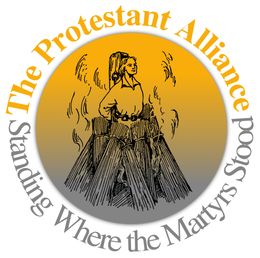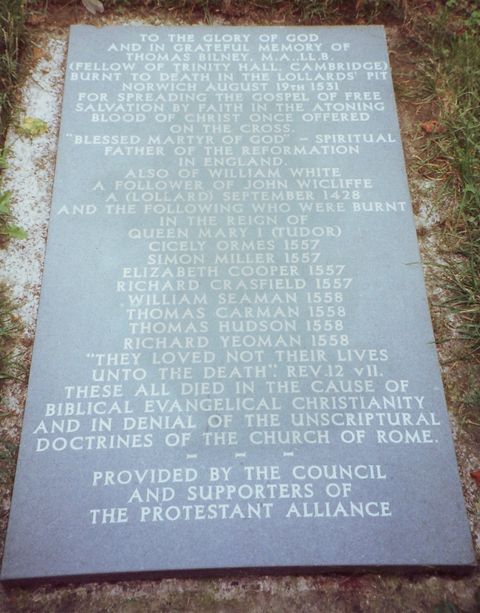
Norwich

Norwich Martyrs’ Memorial
The Martyr’s Memorial was erected by the Protestant Alliance and was unveiled on the afternoon of 29th September 1984 by the Rev David Middleton BD, the pastor of Surrey Chapel, Norwich.
The Rev Middleton addressed the crowd, some of which had traveled large distances to attend the unveiling, and which included many local Ministers.
Wreaths were laid on behalf of the Protestant Reformation Society, the Protestant Society, the Women’s Protestant Union, the National Union of Protestants and the Protestant Alliance.
In the evening a Service of Commemoration was held at the Norwich Railway Mission which was addressed by Dr Stephen Scott-Pearson.
A photograph of the unveiling can be seen if you click the small picture.
Location of Norwich Martyrs' Memorial
THOMAS BILNEY, M.A., LL.B.
The City of Norwich played a vital part in the Reformation. The most important of its martyrs was the little Norwich man and Cambridge scholar, Thomas Bilney. His deep earnest faith and readiness to communicate it to others was a mighty factor in the cause of reform, for he led the great preacher Hugh Latimer to personal faith in Christ.
His influence on Matthew Parker, another Norwich man, to whom he gave his Latin Vulgate Bible before his martyrdom, was significant. Matthew Parker was a remarkable man, for he went into hiding during the reign of Mary I (Tudor) but emerged on the accession of Queen Elizabeth I to become eventually the Archbishop of Canterbury. He took a prominent part in the Protestant Settlement of the Church of England in that reign.
Little Bilney, as Thomas was known to the Reformers, was a very able scholar and came to personal faith in Christ through reading the first chapter of the first epistle of Paul to Timothy.
Long months of deep conviction of sin, of trying by all the means the church offered to find peace with God, ended in realisation of the truth expressed in 1 Timothy 1:15, "This is a faithful saying, and worthy of all acceptation, that Christ Jesus came into the world to save sinners''. Relying on the precious blood shed at Calvary he came to personal faith in the Lord Jesus Christ.
This is the true evangelical position. It was for faith in Christ alone rather than in sacraments that he laid down his life in August 1531 at Norwich during the reign of Henry VIII.
WILLIAM WHITE
The place where the martyrs died was the Lollard's Pit It is not very far from the site of the new memorial located on the embankment at the Yacht Station where it was erected by The Protestant Alliance in 1984. It was so named because Lollards, followers of John Wycliffe, were burnt at the stake there. These were the earliest sufferers in the cause of reform. William White is a typical example of them, being burnt in 1428. He was a priest who, through reading Scripture, the Wycliffe Bible no doubt, came to a personal experience of salvation, left the priesthood and married but continued his ministry of preaching and teaching. He was an early Non-conformist who had come to see that the only source of our Christian Faith is the Word of God, the Bible.
There were other Lollards also who suffered in this place at Norwich. Let us thank God for the Bible and those who in faithfulness to it died so cruel a death. It was in the reign of Henry VI that William White died.
Others of the noble army of martyrs who died at Norwich under Mary I are -
- CICELY ORMES - 1557
- SIMON MILLER - 1557
- ELIZABETH COOPER - 1557
- RICHARD CRASFIELD - 1557
- WILLIAM SEAMAN - 1558
- THOMAS CARMAN - 1558
- THOMAS HUDSON - 1558
- RICHARD YEOMAN - 1558
All of these people were victims of the policy that eventually branded Mary I with the awful title of "Bloody Mary". They died for their denial of the unscriptural doctrine of the Mass. The one final sacrifice of Jesus Christ on Calvary was their only confidence. They believed that there was no other sacrifice for sin but that alone and they also believed that the worship of the wafer in the Mass was idolatry.
This great persecution, in which over 280 were burnt at the stake and 112 died of privation and torture in the prisons, began with the burning of the Rev. John Rogers in Smithfield on 3rd February 1555, and ended with the burning of five at Canterbury on 15th November 1558 in the reign of Mary I.
Follow Us
©
Copyright 2018 The Protestant Alliance All Rights reserved. Privacy Policy.